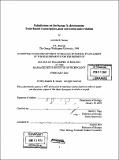Palindromes on the human X chromosome : testis-biased transcription, gene conversion and evolution
Author(s)
Saionz, Jennifer R., 1976-
DownloadFull printable version (5.549Mb)
Other Contributors
Massachusetts Institute of Technology. Dept. of Biology.
Advisor
David C. Page.
Terms of use
Metadata
Show full item recordAbstract
Recent genomic studies of the Y chromosome revealed massive, testis-specific palindromes that span 30% of the chromosome and are subject to gene conversion. We conducted studies to determine whether similar palindromes exist on the human X chromosome and, if they exist, to what degree they share the features of the Y chromosome palindromes. We performed an electronic search for palindromes on the human X chromosome resulting in the identification of 24 palindromes comprising 1.8% of the chromosome. The palindromes consist of sequences 9.5 to more than 140 kilobases long duplicated in inverted orientation separated by a 0.2 to 164 kilobase spacer. The paired palindrome arms display greater than 99 percent nucleotide identity. We determined the palindrome associated gene content and experimentally evaluated their transcription range. All the genes residing in palindrome arms and spacers are transcribed in the testis, with almost two thirds predominantly testis-transcribed. To determine if the testis-transcription bias is due to a chromosome-wide enrichment for testis-transcribed genes, we used publicly available expression data to compare the ratio of palindrome-associated X-linked testis genes with non-palindrome-associated X-linked testis genes. We confirmed that the proportion of testis genes in palindromes is significantly different than that of testis genes on the entire X chromosome. We pursued a comparative sequencing strategy to trace the evolution of the X chromosome palindromes. We sequenced bacterial artificial chromosomes (BACs) from chimpanzee, orangutan and rhesus monkey genomic libraries containing sequence orthologous to several of the human X chromosome palindromes. We found some of the palindromes conserved in all species (cont.) the origins of these palindromes before the rhesus monkey and human lineages split 25 million years ago. Despite their ancient origin, all of the palindromes studied display greater than 99 percent nucleotide identity between paired arms, suggesting that gene conversion between palindrome arms maintains the arm to arm similarity. We also uncovered insertions and deletions between orthologous palindrome arms that had been subsequently homogenized to the opposite arm of the palindrome. The largest deletion of 14.5 kilobases is the largest known example of a gene conversion homogenized indel in mammals.
Description
Thesis (Ph. D.)--Massachusetts Institute of Technology, Dept. of Biology, 2005. Text of thesis refers to CDROM as Appendix A. Includes bibliographical references.
Date issued
2005Department
Massachusetts Institute of Technology. Department of BiologyPublisher
Massachusetts Institute of Technology
Keywords
Biology.